Before Yuri Gagarin made history by becoming the first man in space on April 12, 1961, a long succession of non-human astronauts had already been shot through the atmosphere in order to determine if life forms could survive spaceflight. Even after manned space missions became routine procedures, many different animals continued to be used for space experiments.
Animal astronauts have been instrumental in helping humans succeed in space, so it is to them that this list is dedicated.
10. Mice
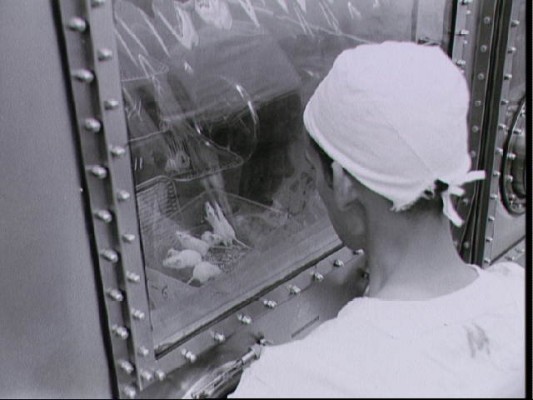
Some of the earliest animals in space were mice. On August 31, 1950, the fifth flight of the famous “Albert” Series of V2 launches contained a mouse. Unfortunately, the parachute recovery system failed and the mouse was more or less annihilated on impact.
Eleven mice were on board the 1951 U.S. Aerobee missile flight that carried Yorick, the first monkey recovered alive after a rocket flight. The U.S. also sent mice on three rocket re-entry tests during the 1958 “Mouse In Able” project (all three died). In addition, fourteen more mice perished on a Jupiter rocket after they lifted off from Cape Canaveral in 1959.
Bonus: first rat in space – In February of 1961, France sent a rat named Hector into space. After flying to a height of 93 miles, Hector was successfully recovered.
9. Guinea pigs
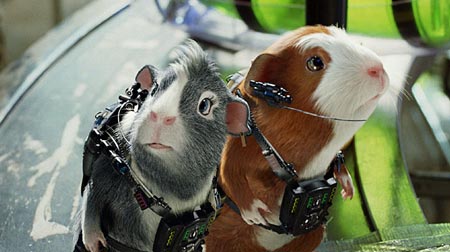
The first guinea pig space invader flew with the Soviet Sputnik 9 spacecraft on March 9, 1961, along with a dog named Chernushka, a dummy cosmonaut named Ivan Ivanovich, and an assortment of mice and reptiles. Ivan safely parachuted back to earth (thank God), and the animals made it back to alive.
On October 5, 1990, China launched the biosatellite FSW-1 3 containing a collection of 60 plants and animals that included guinea pigs. After eight days, the biosat was successfully recovered.
8. Newts
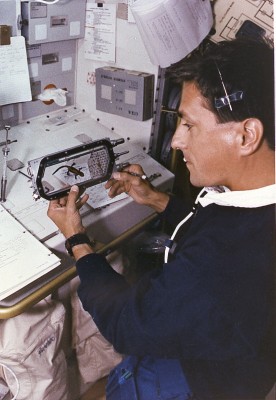
The Bion 7 mission (1985) carried 10 Iberian ribbed newts on board, along with a host of other biological specimens (including two monkeys). In order to provide insight about injuries and regeneration rates in space, the unfortunate newts had portions of their front limbs lopped off and parts of their lenses removed. Researchers observed that the newts were able to regenerate significantly faster while in space.
Newts were taken on other Bion flights as well. They have also been used for experiments on the Columbia (1994), the Foton-M2 mission (2005), Japan’s Space Flyer Unit (1995), and the Mir Space Station.
7. Frogs
In 1970, NASA launched something called the Orbiting Frog Otolith program by sending two bullfrogs into orbit (the word otolith refers to an inner-ear mechanism for controlling equilibrium). The OFO experiment was developed so that scientists could determine how the otolith adapted to weightlessness.
The frogs were in space from November 9-15 and the experiment was a success… from the scientists’ point of view, that is. Researchers were able to collect the neurophysiological data they wanted, but the spacecraft wasn’t recovered.
6. Fish
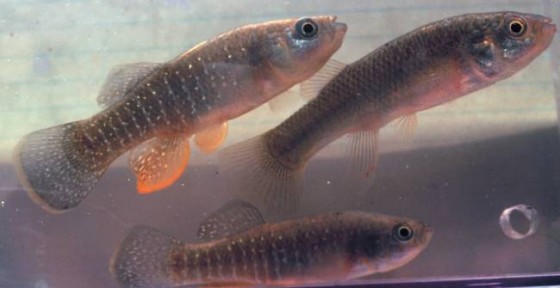
The first kind of fish in space was a mummichog, a strong little aquatic specimen that is often used for research projects because of its ability to survive extreme conditions. A pair of mummichogs accompanied Skylab 3 (1973) to provide more information about the otolith organ.
Mummichogs were part of later space flights as well. Many other kinds of fish have also been in space – for instance, guppies, zebra danios, carp, swordtails, Japanese killifish, and oyster toadfish, to name a few.
5. Turtles
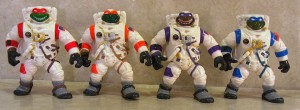
If we don’t count Teenage Mutant Ninjas, then the first turtles entered space back in 1968. And it wasn’t just orbital space, either – we’re talking deep space. As in “Let’s Fly To The Moon” space.
On September 15, 1968, the Soviets launched the Zond 5 spacecraft with a biological payload that included two turtles. On September 18, Zond 5 made a loop around the moon and safely returned to earth on the 21st. The turtles had suffered slight weight loss, but hey, that’s a whole lot better than erupting in flames and burning to death during reentry.
The Soviet Soyuz 20 mission (November 17, 1975 – February 16, 1976) kept tortoises in space for 90.5 days, setting a duration record for animals. In addition, Iran’s recent Kavoshgar 3 rocket launch (February 2010) included two turtles, a rat, and some worms.
4. Cats
Once again, our hats must go off to the French. Not happy with just firing the first rat into space, France decided they would also send up the very first space cat in October of 1963. So they found themselves a street cat, named it Felix, strapped it into a Véronique AGI rocket, and hurled it heavenward. And yes, it survived!
One week later, however, they launched a second cat. Let’s just say that one wasn’t quite as lucky…
Note – some sources indicate that Felix ran away at the last minute, and the cat actually launched was a female named Felicette. Either way, France gets the First Cat In Space award.
3. Spiders
Several different space spiders could be mentioned, but the 1973 Skylab 3 space mission carried the first ones – a couple of European garden spiders named Arabella and Anita. The “spiders in space” experiment was a science project dreamed up by a student named Judy Miles, and the idea was to observe how weightlessness and spaceflight would affect web construction.
Both spiders managed to spin webs, although Arabella finished hers first. The webs took longer than normal to complete, of course, and displayed some variations when compared to normal webs on Earth. Scientists later determined that although the space webs contained differences in thickness, they were of a finer quality overall.
Both spiders died in space – apparently from dehydration – and their bodies are now on display at the Smithsonian.
2. Monkeys
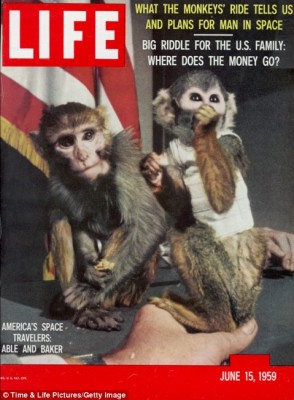
In the late 1940s, the United States began catapulting various life forms into the sky on V-2 rockets, starting with fruit flies in 1947 (which, by the way, were recovered alive and well). The Air Force Aeromedical Laboratory “Albert” flights (June 1948 – August 1950) at White Sands, NM were the first experiments to use primates. The first Albert was launched on June 11, 1948. He didn’t survive (actually, he didn’t even make it to space).
On June 14, 1949, Albert II became the first monkey in space when he reached an altitude of 83 miles. Immediately thereafter, he became the first space monkey to die on impact.
As noted above, Yorick and his 11 mice crewmates survived rocket flight on September 20, 1951, although they didn’t make it to space (and Yorick died two hours after recovery). However, on May 28, 1959 two monkeys named Able and Baker blasted to a height of more than 300 miles and were later recovered – which makes them the first monkeys to survive a flight in actual space. Sadly, Able passed away a few days later as doctors were trying to remove an infected electrode.
Many other U.S. monkeys could also be mentioned – for instance, there’s Sam, a rhesus monkey launched from Brooks Air Force Base in Texas (Dec. 4, 1959), Ham, the first chimp in space (Jan. 31, 1961), and Enos, the first chimp to orbit the earth (Nov. 29, 1961).
Other countries had monkey astronauts, too. The Soviet Bion space program used them during the 80s and 90s. One of them (named Dryoma) even became a gift for Fidel Castro after a successful spaceflight on Bion 8. The French sent a couple of pig-tailed macaques to space in 1967, and Argentina shot off two cai monkeys in 1969 and 1970.
1. Dogs
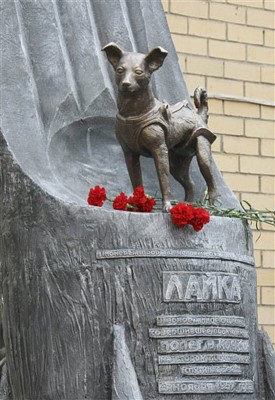
The Soviets preferred to use pairs of stray female dogs for their early space experiments in the 50s and 60s. Most of those flights were successful, and some dogs flew more than once. In 1951, Dezik and Tsygan became the first canines to survive spaceflight. Unfortunately, Dezik perished in a subsequent launch.
The most famous space dog is probably Laika, who became the first living being in orbit when she flew with the Sputnik 2 rocket on November 3, 1957. She didn’t live through the ordeal, though, dying of stress and overheating after only a few hours. It wasn’t until 1960 that animals would return alive from an orbital flight. The Soviet dogs Belka and Strelka (along with a rabbit, a bunch of mice, two rats, and other biological specimens) first accomplished this feat on the Sputnik 5. One of Strelka’s puppies was later given as a present to President Kennedy’s daughter.
Veterok and Ugolyok also deserve to be mentioned – in 1966, they made it back to earth without burning up or exploding after spending 22 days in orbit… human astronauts didn’t break this record until 1973 (Skylab 2).
Bonus awesomeness – during the European Space Agency’s September 2007 Foton-M3 mission, a group of tiny, nearly indestructible tardigrades (“water bears”) became the first animals to survive exposure to the vacuum and intense radiation of open space. And they did it for ten days.
Many more animal astronauts could also be mentioned in this list: scorpions, nematodes, cockroaches, bees, silkworms, snails, ants, crickets, sea urchins, shrimp, butterfly larvae – all of these (and probably some others) have made it into space.
So, do you have any interesting stories about animals in space? Did I miss a good one? Leave a comment and share what you know!
